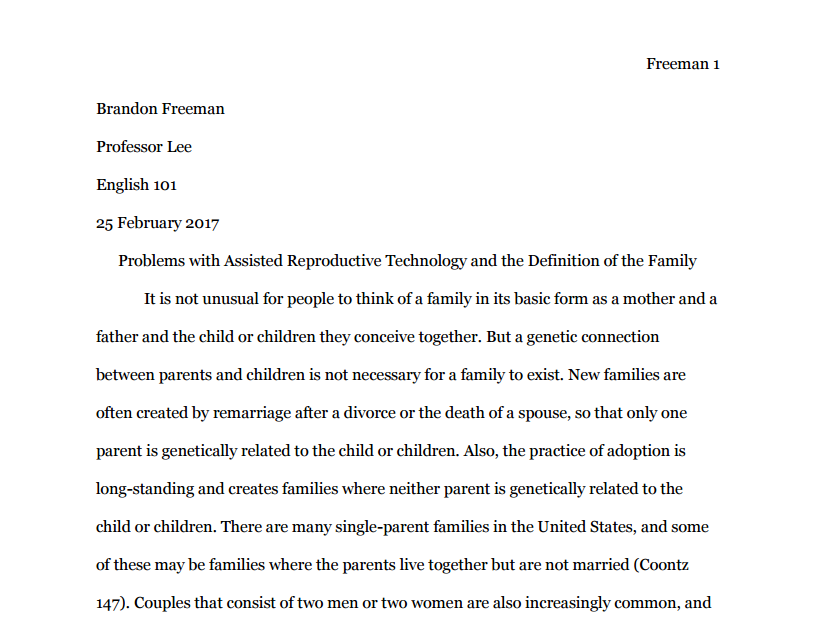Learning Objectives
- Describe overall MLA document formatting, including page layout
Overall Structure of an MLA Paper
One purpose of using MLA format is to streamline the writing process and establish a consistent and uniform way of presenting the material. For this reason, there are specific guidelines you’ll need to follow when formatting your paper.
WATCH IT
Watch this video to get an overall feel for the style and format of a paper written in MLA style.
You can view the transcript for “MLA Overview” here (opens in new window).
General MLA Formatting Rules
- Font: Your paper should be written in 12-point text. Whichever font you choose, MLA requires that regular and italicized text be easily distinguishable from each other. Times and Times New Roman are often recommended.
- Line Spacing: All text in your paper should be double-spaced.
- Margins: All page margins (top, bottom, left, and right) should be 1 inch. All text should be left-justified.
- Indentation: The first line of every paragraph should be indented 0.5 inches.
- Page Numbers: Create a right-justified header 0.5 inches from the top edge of every page. This header should include your last name, followed by a space and the page number. Your pages should be numbered with Arabic numerals (1, 2, 3…) and should start with the number 1 on your title page. Most word-processing programs have the ability to automatically add the correct page number to each page, so you don’t have to do this by hand.
- Use of Italics: In MLA style, you should italicize (rather than underline) the titles of books, plays, or other standalone works. You should also italicize (rather than underline) words or phrases you want to lend particular emphasis—though you should do this rarely.
- Sentence Spacing: Include just one single space after a period before the next sentence: “Mary went to the store. She bought some milk. Then she went home.”
- The First Page: Like the rest of your paper, everything on your first page, even the headers, should be double-spaced. The following information should be left-justified in regular font at the top of the first page (in the main part of the page, not the header):
- on the first line, your first and last name
- on the second line, your instructor’s name
- on the third line, the name of the class
- on the fourth line, the date in military-style format: day month year
- The Title: After the header, the next double-spaced line should include the title of your paper. This should be centered and in title case, and it should not be bolded, underlined, or italicized (unless it includes the name of a book, in which case just the book title should be italicized).
- The Oxford Comma: The Oxford comma (also called the serial comma) is the comma that comes after the second-to-last item in a series or list. For example: The UK includes the countries of England, Scotland, Wales, and Northern Ireland. In the previous sentence, the comma immediately after “Wales” is the Oxford comma. In general writing conventions, whether the Oxford comma should be used is actually a point of fervent debate among passionate grammarians. However, it’s a requirement in MLA style, so double-check all your lists and series to make sure you include it!
- Subheadings: If you include subheadings, they should be bolded and left-justified (not indented or centered).
Essentially, your paper should look like this:

Figure 1. This sample paper shows how the first page of a paper written in MLA is formatted. Note the header information in the upper-left corner, the last name and page numbers in the upper-right corner, the double spaced text, and indentations that begin each paragraph.
Try It
LINK TO LEARNING
Need help with creating an MLA style document? You can use this MLA formatted template to help you get started, or watch this video to set it up in Google docs or this video to set it up in Microsoft Word. Look at this student essay to see an example of appropriate formatting.
Candela Citations
- Revision and Adaptation. Provided by: Lumen Learning. License: CC BY-SA: Attribution-ShareAlike
- Overall Structure and Formatting of an MLA Paper. Provided by: Boundless. Located at: https://www.boundless.com/writing/textbooks/boundless-writing-textbook/writing-a-paper-in-mla-style-humanities-255/introduction-to-mla-style-299/overall-structure-and-formatting-of-an-mla-paper-301-16889/. Project: Boundless Writing. License: CC BY-SA: Attribution-ShareAlike
- MLA 8th Edition - What's New?, sample student paper. Provided by: College of DuPage Library . Located at: http://www.codlrc.org/IL/Future/MLA. License: CC BY: Attribution
- MLA: The Works Cited Section. Authored by: Boundless. Located at: https://www.boundless.com/writing/textbooks/boundless-writing-textbook/writing-a-paper-in-mla-style-humanities-255/mla-citations-and-references-303/mla-the-works-cited-section-319-16905/. Project: Boundless Writing. License: CC BY-SA: Attribution-ShareAlike
- MLA Style Demo. Provided by: Excelsior OWL. Located at: https://owl.excelsior.edu/citation-and-documentation/mla-style/mla-style-demo/. License: CC BY: Attribution
- MLA Document Template. Provided by: Lonestar College. Located at: https://upresearch.lonestar.edu/mla/start. Project: Research Guides. License: CC BY-SA: Attribution-ShareAlike
